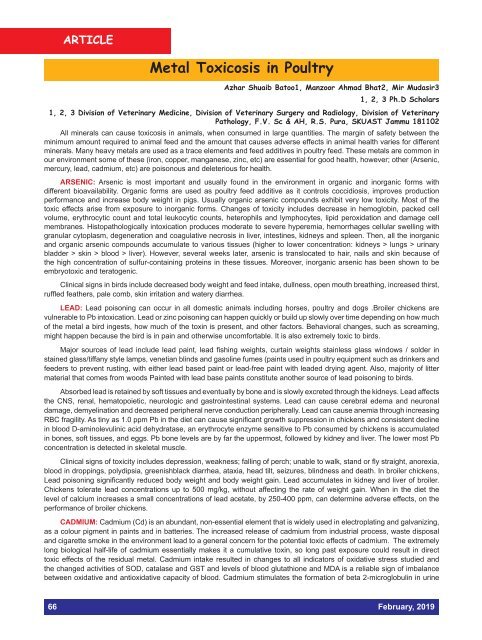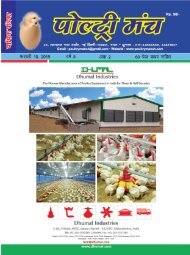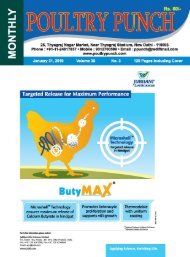POULTRY PUNCH - FEBRUARY 2019
POULTRY PUNCH - FEBRUARY 2019
POULTRY PUNCH - FEBRUARY 2019
- No tags were found...
You also want an ePaper? Increase the reach of your titles
YUMPU automatically turns print PDFs into web optimized ePapers that Google loves.
ARTICLE NEWS<br />
Metal Toxicosis in Poultry<br />
Azhar Shuaib Batoo1, Manzoor Ahmad Bhat2, Mir Mudasir3<br />
1, 2, 3 Ph.D Scholars<br />
1, 2, 3 Division of Veterinary Medicine, Division of Veterinary Surgery and Radiology, Division of Veterinary<br />
Pathology, F.V. Sc & AH, R.S. Pura, SKUAST Jammu 181102<br />
All minerals can cause toxicosis in animals, when consumed in large quantities. The margin of safety between the<br />
minimum amount required to animal feed and the amount that causes adverse effects in animal health varies for different<br />
minerals. Many heavy metals are used as a trace elements and feed additives in poultry feed. These metals are common in<br />
our environment some of these (iron, copper, manganese, zinc, etc) are essential for good health, however; other (Arsenic,<br />
mercury, lead, cadmium, etc) are poisonous and deleterious for health.<br />
ARSENIC: Arsenic is most important and usually found in the environment in organic and inorganic forms with<br />
different bioavailability. Organic forms are used as poultry feed additive as it controls coccidiosis, improves production<br />
performance and increase body weight in pigs. Usually organic arsenic compounds exhibit very low toxicity. Most of the<br />
toxic effects arise from exposure to inorganic forms. Changes of toxicity includes decrease in hemoglobin, packed cell<br />
volume, erythrocytic count and total leukocytic counts, heterophils and lymphocytes, lipid peroxidation and damage cell<br />
membranes. Histopathologically intoxication produces moderate to severe hyperemia, hemorrhages cellular swelling with<br />
granular cytoplasm, degeneration and coagulative necrosis in liver, intestines, kidneys and spleen. Then, all the inorganic<br />
and organic arsenic compounds accumulate to various tissues (higher to lower concentration: kidneys > lungs > urinary<br />
bladder > skin > blood > liver). However, several weeks later, arsenic is translocated to hair, nails and skin because of<br />
the high concentration of sulfur-containing proteins in these tissues. Moreover, inorganic arsenic has been shown to be<br />
embryotoxic and teratogenic.<br />
Clinical signs in birds include decreased body weight and feed intake, dullness, open mouth breathing, increased thirst,<br />
ruffled feathers, pale comb, skin irritation and watery diarrhea.<br />
LEAD: Lead poisoning can occur in all domestic animals including horses, poultry and dogs .Broiler chickens are<br />
vulnerable to Pb intoxication. Lead or zinc poisoning can happen quickly or build up slowly over time depending on how much<br />
of the metal a bird ingests, how much of the toxin is present, and other factors. Behavioral changes, such as screaming,<br />
might happen because the bird is in pain and otherwise uncomfortable. It is also extremely toxic to birds.<br />
Major sources of lead include lead paint, lead fishing weights, curtain weights stainless glass windows / solder in<br />
stained glass/tiffany style lamps, venetian blinds and gasoline fumes (paints used in poultry equipment such as drinkers and<br />
feeders to prevent rusting, with either lead based paint or lead-free paint with leaded drying agent. Also, majority of litter<br />
material that comes from woods Painted with lead base paints constitute another source of lead poisoning to birds.<br />
Absorbed lead is retained by soft tissues and eventually by bone and is slowly excreted through the kidneys. Lead affects<br />
the CNS, renal, hematopoietic, neurologic and gastrointestinal systems. Lead can cause cerebral edema and neuronal<br />
damage, demyelination and decreased peripheral nerve conduction peripherally. Lead can cause anemia through increasing<br />
RBC fragility. As tiny as 1.0 ppm Pb in the diet can cause significant growth suppression in chickens and consistent decline<br />
in blood D-aminolevulinic acid dehydratase, an erythrocyte enzyme sensitive to Pb consumed by chickens is accumulated<br />
in bones, soft tissues, and eggs. Pb bone levels are by far the uppermost, followed by kidney and liver. The lower most Pb<br />
concentration is detected in skeletal muscle.<br />
Clinical signs of toxicity includes depression, weakness; falling of perch; unable to walk, stand or fly straight, anorexia,<br />
blood in droppings, polydipsia, greenishblack diarrhea, ataxia, head tilt, seizures, blindness and death. In broiler chickens,<br />
Lead poisoning significantly reduced body weight and body weight gain. Lead accumulates in kidney and liver of broiler.<br />
Chickens tolerate lead concentrations up to 500 mg/kg, without affecting the rate of weight gain. When in the diet the<br />
level of calcium increases a small concentrations of lead acetate, by 250-400 ppm, can determine adverse effects, on the<br />
performance of broiler chickens.<br />
CADMIUM: Cadmium (Cd) is an abundant, non-essential element that is widely used in electroplating and galvanizing,<br />
as a colour pigment in paints and in batteries. The increased release of cadmium from industrial process, waste disposal<br />
and cigarette smoke in the environment lead to a general concern for the potential toxic effects of cadmium. The extremely<br />
long biological half-life of cadmium essentially makes it a cumulative toxin, so long past exposure could result in direct<br />
toxic effects of the residual metal. Cadmium intake resulted in changes to all indicators of oxidative stress studied and<br />
the changed activities of SOD, catalase and GST and levels of blood glutathione and MDA is a reliable sign of imbalance<br />
between oxidative and antioxidative capacity of blood. Cadmium stimulates the formation of beta 2-microglobulin in urine<br />
66 February, <strong>2019</strong>






